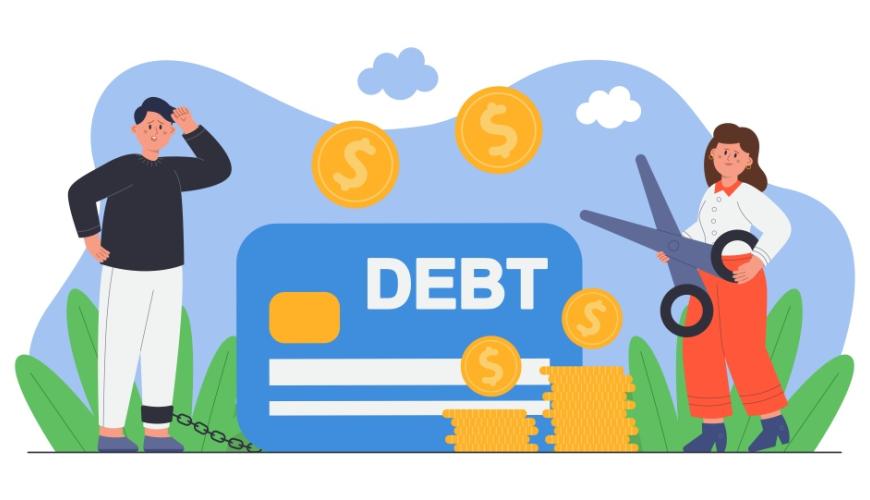Managing Your Debt
- 29 May 2024 2:34 PM

Contents
How to make a plan for tackling your debt, improving your credit score and feel like the money you owe isn’t controlling you.
Many of us make one of the most consequential financial decisions of our lives before we even hit the legal drinking age: borrowing money for college.
The college acceptance letter is followed by the financial aid package (“aid,” lol), which is really just a nicer way of stating how much debt you’ll need to amass to pay for your degree.
It’s at that moment that Americans — teenagers! — have their first encounter with the debt culture that’s ingrained in how we pay for just about everything. It’s always there, for the taking, to buy cars, homes, Lululemon leggings and more. U.S. households carry more than $17 trillion, for all of it, including credit cards.
So while we’ve normalized indebtedness in this country, we’ve also moralized it: If you have debt that you can’t afford to pay back, you must have done something very wrong.
Yet we know that’s often the furthest thing from the truth. Many people accumulate debt, not because of lattes, nice sweaters and exotic vacations, but because of circumstances beyond their control, from health issues to job loss.
Then there are the structural reasons that most people borrow, like wages not keeping pace with education costs and a societal decision to push more of the burden onto individuals. We should all be asking big, basic questions about how we landed here — where college degrees often feel like luxury products and medical debts often drive bankruptcies — and what it would take to change the status quo.
For now, we’re going to focus on the microeconomy that is you: How to improve your credit standing, avoid debt where you can and manage the debt you have so it doesn’t feel like it’s controlling you.
Spending Awareness
The first part of debt management is simply becoming more aware of where your money goes and spending with intention, just as Ron discussed in the third boot camp session.
In an increasingly cashless society, it’s become easier to lose track of our spending because there’s little friction — you don’t even need to pull out a piece of plastic from a wallet, you can just tap your phone, and some money is charged to your credit card or siphoned from your bank account.
Buy now-pay later apps, which enable you to pay for just about everything with a no-interest installment loan, instantaneously underwritten from somewhere deep inside your mobile phone, can be similarly pernicious.
Understanding Your Credit Profile
Look at debt as a tool that you have to use carefully. It can also help improve your credit profile — and may have already.
In fact, people with debt who make timely payments may already have solid credit scores, the three-digit number that lenders use to judge you when deciding whether to make you a loan (and how much interest to charge for it). Landlords often use them when considering rental applications.
But having too much debt can drag down your score, which generally ranges from 300 to 850 — the higher, the better. (At FICO, a score of more than 740 is considered “very good.”)
The bottom line: Paying down debt regularly will help strengthen solid scores and improve less-than-perfect scores, which can lead to better interest rates later. (We’ll provide more information on how to find your scores in the action items section below.)
Got Debt? Make a Plan
There are several different approaches to tackling credit card debt:
- Don’t forget one of the oldest tricks: ye olde balance transfer offer, where you transfer your debt to a credit card with an introductory rate of zero percent. With interest rates on the rise, these deals are harder to find, but it’s worth a shot. Be sure to evaluate the transfer fees (which have risen) and how much you would need to pay each month to be debt-free once the introductory rate expires.
- Consolidating your debts into a personal loan is another option. The interest rates are nearly as high as those for credit cards, but there is some variability across lenders, so it pays to shop around. You may get lucky, especially if you have a strong credit score.
- For people with debt on multiple credit cards, the so-called avalanche method is the most practical — you focus on paying down your highest-cost debt first. Pay the monthly minimums on all of your card debts (to avoid any late fees). Then, throw the money you have left over toward your credit-card balance with the highest interest rate. Once that is zapped, put the extra money toward the next highest-cost debt.
- The second strategy, known as the snowball method, may be more psychologically rewarding for people who want a quicker win. Here too, you pay the monthly minimums on all of your debts, but put the extra money toward your smallest-balance debt first. The logic here? You knock out debts more quickly, which can be highly motivating and spur you to keep going.
- Some people like to combine the two — snowball first, for a quick victory, then follow with avalanche.
If at any point you feel stuck, there are professionals who can help. They may even be able to negotiate a repayment plan with your credit card companies (but beware of scam artists who make promises that sound too good to be true). Your safest bet is to find a nonprofit credit counseling agency through the National Foundation for Credit Counseling.
Medical Debt
Medical debt is a bit different from other consumer debts. After you’ve made sure that the bill is accurate and your insurance (if you have it) paid every last cent that it should, ask your medical provider to reduce the bill to a more manageable amount, and then work out a payment plan. Even if collectors are hounding you, don’t put the debt on your credit card. Here’s why: Once you do, it will look just like any other consumer debt.
Why is that important? The big credit reporting agencies have begun to view medical debts a bit less punitively. (Read a piece by my colleague Ann Carrns for more information.)
Managing Your Student Loans
If you’ve already amassed some credit card debt but also have student loans, you’re probably wondering how to balance the two. Even though federal student loan rates have risen, they’re still far less than most credit cards, which now carry insanely high rates of 22 percent, on average. The same rules apply here: You want to stay current on your student loans while also attacking your highest-rate debt first.
If you’re overwhelmed with other consumer debts, there may be a way to safely reduce your student loan payment while you focus on the former. Run your numbers on Studentaid.gov’s loan simulator, which will calculate your monthly payments under different repayment plans, along with how much you will pay in interest over the life of the loan.
But that’s a step that all student borrowers should take to ensure you’re in the best repayment plan, given your circumstances.
For people struggling to make ends meet, income-driven repayment, or I.D.R., plans may be the most affordable option: They base your monthly payment on your discretionary income and household size. After you make payments for a set period, somewhere between 10 and 20 years, the remaining debt is cancelled.
The Biden administration’s new I.D.R. plan, called SAVE, is the most generous version (which is why it’s being challenged by more than a dozen Republican-led states). Anyone working in public service or at a nonprofit should also consider the Public Service Loan Forgiveness program, which may provide an even faster path to eradicating your federal student debts.
If you also have private student loans through commercial lenders, there are a few things you should bear in mind. Federal student loans have embedded protections that private loans do not — I.D.R. programs may not require you to pay anything at all if your income is wiped out or you’re making a minimum wage, for example, and tools like forbearance allow you to temporarily hit the pause button on payments. If you ever consider refinancing your federal student debt with a commercial lender, you give all of that up.
It’s a lot to take in. If you’d like some hand-holding, there are experts at organizations like TISLA who can assist.
The journey through your 20s is a time of self-discovery, including your financial personality. You may make suboptimal decisions that you may not even necessarily regret, but those choices will teach you. As long as the lesson isn’t lost, you will have gained something.
Action items:
- Your family background has probably influenced your outlook on debt. Did your family save for big purchases? Borrow constantly for financial emergencies? Or perhaps they were financially comfortable, but still managed to overextend themselves? Think about how your life experience thus far may have shaped your approach toward debt as an adult.
- Make a list of all of your debts, along with the interest rate you are paying on each. Can you optimize in any way?
- Everyone has a credit file at each of the three major credit reporting companies (Equifax, Experian and TransUnion). Pull each of yours (using this website only, where you receive a free report from each bureau weekly) and scan it for errors. You can dispute any errors online.
- Do you know your credit score? There are several places to look.
- Don’t have debt? Reacquaint yourself with the reward terms and interest rate on your credit card — can you do better?

